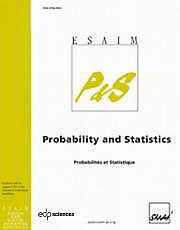Article contents
Digital search trees and chaos game representation*
Published online by Cambridge University Press: 21 February 2009
Abstract
In this paper, we consider a possible representation of a DNA sequence in a quaternary tree, in which one can visualize repetitions of subwords (seen as suffixes of subsequences). The CGR-tree turns a sequence of letters into a Digital Search Tree (DST), obtained from the suffixes of the reversed sequence. Several results are known concerning the height, the insertion depth for DST built from independent successive random sequences having the same distribution. Here the successive inserted words are strongly dependent. We give the asymptotic behaviour of the insertion depth and the length of branches for the CGR-tree obtained from the suffixes of a reversed i.i.d. or Markovian sequence. This behaviour turns out to be at first order the same one as in the case of independent words. As a by-product, asymptotic results on the length of longest runs in a Markovian sequence are obtained.
Keywords
- Type
- Research Article
- Information
- Copyright
- © EDP Sciences, SMAI, 2009
References
- 1
- Cited by


